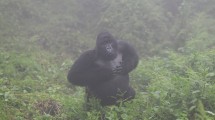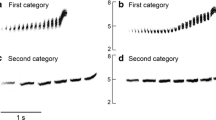Summary
During contests animals typically exchange information about fighting ability. Among feral horses these signals involve olfactory or acoustical elements and each type can effectively terminate contests before physical contact becomes necessary. Dung transplant experiments show that for stallions, irrespective of rank, olfactory signals such as dung sniffing encode information about familiarity suggesting that such signals can be used as signatures. As such they can provide indirect information about fighting ability as long as opponents associate identity with past performance. Play-back experiments, however, show that vocalizations, such as squeals, directly provide information about status regardless of stallion familiarity. Sonographs reveal that squeals of dominants are longer than those of subordinates and that only those of dominants have at their onset high-frequency components.
Similar content being viewed by others
References
Berger, J. (1986)Wild Horses of the Great Basin. Chicago University Press, Chicago, USA.
Clutton-Brock, T. H. and Albon, S. D. (1979) The roaring of red deer and the evolution of honest advertisement.Behaviour 69, 145–70.
Collias, J. (1943) Statistical analysis of factors which make for success in initial encounters between hens.Am. Nat. 72, 519–38.
Conner, D. A. (1985) The function of the Pika's short call in individual recognition.Z. Tierpsychol. 67, 131–43.
Davies, N. B. and Halliday, T. R. (1978) Deep croaks and fighting assessment in toads,Bufo bufo. Nature (Lond.) 274, 683–5.
Duncan, P. (1983) Determinants of the use of habitat by horses in a Mediterranean wetland.J. Anim. Ecol. 52, 93–111.
Gosling, L. M. (1982) A reassessment of the function of scent marking in territories.Z. Tierpsychol. 60, 89–118.
Jarvi, T. and Bakken, M. (1984) The function of the variation in the breast stripe of the great tit (Parus major).Anim. Behav. 32, 590–6.
Krebs, J. R. (1982) Territorial defence in the great tit (Parus major): Do residents always win?Behav. Ecol. Sociobiol. 11, 185–94.
Maynard Smith, J. (1976) Evolution and the theory of games.Am. Sci. 64, 41–5.
Maynard Smith, J. and Parker, G. A. (1976) The logic of asymmetric contests.Anim. Behav. 24, 159–75.
Parker, G. A. and Rubenstein, D. I. (1981) Role assessment, reserve strategy and acquisition of information in asymmetric animal conflicts.Anim. Behav. 29, 221–40.
Robertson, J. G. (1986) Male territoriality, fighting and assessment of fighting ability in the Australian frogUperleia rugosa.Anim. Behav. 34, 763–72.
Rohwer, S. (1975) The social significance of avian winter plumage variability.Evolution 29, 593–610.
Rohwer, S. and Rohwer, F. C. (1978) Status signalling in harris sparrows: experimental deception achieved.Anim. Behav. 26, 1012–22.
Rubenstein, D. I. (1981) Behavioral ecology of island feral horses.Equine Vet. J. 13, 27–34.
Rubenstein, D. I. (1986) Ecology and sociality in horses and zebras. InEcological Aspects of Social Evolution (D. I. Rubenstein and R. W. Wrangham, eds), pp. 282–302. Princeton University Press, USA.
Ryan, M. J. (1985)The Tungra Frog. Princeton University Press, USA.
Whitfield, D. P. (1987) The social significance of plumage variability in wintering turnstoneArenaria interpses.Anim. Behav. 36, 408–15.
Author information
Authors and Affiliations
Rights and permissions
About this article
Cite this article
Rubenstein, D.I., Hack, M.A. Horse signals: The sounds and scents of fury. Evol Ecol 6, 254–260 (1992). https://doi.org/10.1007/BF02214165
Issue Date:
DOI: https://doi.org/10.1007/BF02214165




